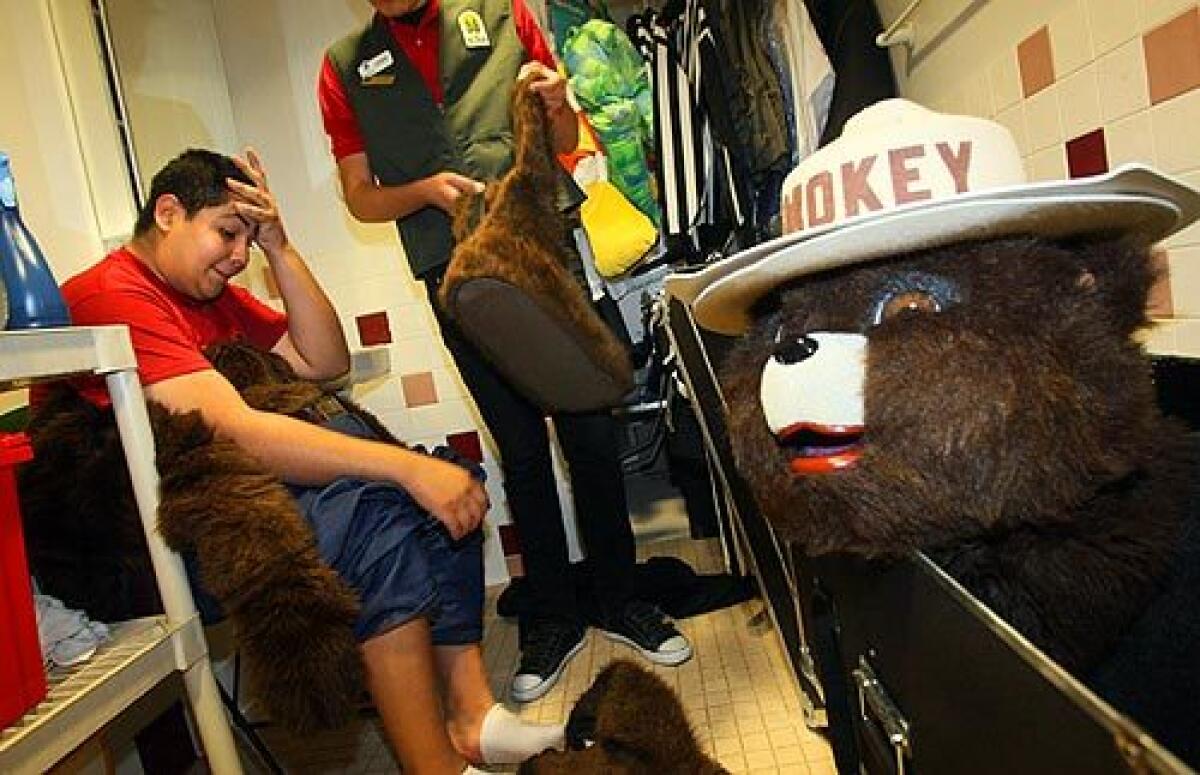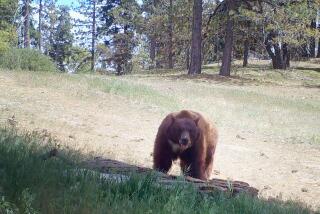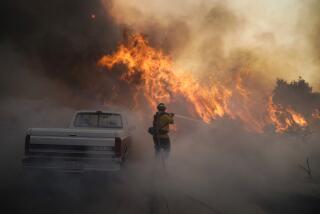At 65, Smokey Bear is still fighting fires

He’s a war hero who became a media mogul, celebrity pitchman, pop icon and philanthropist. He’s so famous he was given his own ZIP Code, 20252, to handle the fan mail. He is 65 years old but has no intention of retiring. In fact, he looks fitter than ever.
Working outdoors with a shovel will do that.
Smokey Bear was born in August 1944, sired by a committee of ad men and government bureaucrats hoping to safeguard a key war material: wood. Smokey today remains the face of the longest-running public service campaign in U.S. history -- a simple message delivered by an anthropomorphic bear.
But Smokey’s story is anything but simple. His uncompromising stance -- “Only you can prevent forest fires” -- helped alter the landscape by reinforcing the idea that fire was an enemy that should be eliminated, that the price to be paid for living in the path of wildfire was vigilance and will.
Smokey’s critics say decades of fire suppression helped create forests unnaturally thick with fuel, setting the stage for the infernos that march across the West every year. A sign on forestry professor Ron Wakimoto’s office door at the University of Montana sums up this thinking: “Smokey is dead -- prescribe forest fires.”
“The forest conditions we have today are directly the result of that campaign,” said Wakimoto, a wildfire policy expert who has testified before Congress. “Historically, it’s done its damage by creating a very flammable forest.”
A few years ago, Smokey’s message was tweaked. “Only you can prevent wildfires” makes a subtle distinction intended to reinforce that there are bad fires (intentionally or accidentally set) and fires that promote healthy, less-combustible forests.
Still, Smokey seems a slightly out-of-step missionary in the ever-evolving politics of fire in the West. His message avoids the complex social issues surrounding wildfire. What should be allowed to burn and what should be burned on purpose? If we choose to live in fire country, who should protect us and at what cost?
“I’m not an ad man,” Wakimoto said. “With all the different messages that should be conveyed, I can’t see Smokey laying out something that nuanced.”
Bring this up with one of Smokey’s legion of adoring fans -- baby boomers who see him as an emblem of a wholesome bygone era -- and you risk getting punched in the snout.
And please don’t call him Smokey the Bear, because the big fella has no middle name.
The protectiveness afforded Smokey begins with the government. His image is tightly controlled. Unauthorized use violates federal law (88 Stat. 244; 31 U.S.C. 488a; 488b-6; 18 U.S.C. 711, 711a). Those who tread on the government’s trademark risk a visit from the FBI and a $150,000 fine. But most cases are solved with a stern letter from the company contracted to license Smokey’s image.
“We take it very seriously,” said Libby Kavoulakis, who oversees Smokey for the Metis Group, a marketing firm in Washington, D.C. “It’s ridiculous what you see people do with Smokey. There’s always someone out there who has Smokey with a joint. Or different signs in bars in which he is encouraging cigarette smoking. . . . Rude actions in the forest -- Smokey going to the bathroom. It was on a greeting card. We stopped that one too.”
Smokey Bear is a $1-million-a-year-plus industry. About 100 manufacturers slap Smokey’s image on apparel and tchotchkes, home furnishings and jewelry. A 6-foot, three-dimensional fiberglass figure with steel frame from an Idaho company will set you back $3,500. Licensing fees, which range from 5% to 10%, support fire-prevention education.
Smokey works for the U.S. Department of Agriculture and doesn’t shill for anyone. His appearance in 1998 at several car shows as part of a deal between Subaru and a nonprofit foundation that raises money for the Forest Service prompted a federal investigation and criticism in Congress. Subaru dropped out.
“If someone wants to make candles or gas-fired lanterns, we’re going to say no,” Kavoulakis said. “Certain types of apparel like halters and underwear are out too.”
Entrepreneur Robin Sykes recalls the moment inspiration hit her husband, Bill, like a pine cone to the head. It was 1980, and the couple were driving to Montana past miles and miles of forest blackened by wildfire.
“We were talking about how you have all these idiots throwing cigarettes out the window,” Sykes said. “And my husband says: ‘I got an idea: Smokey Bear antenna balls!’ ”
With those words, their company, Smokey Signals, was born.
“My husband figured if he could sell a million Smokey antenna balls for a dollar apiece, he could retire,” she said.
Did it work?
“Hell, no!”
Nevertheless, their Northern California business has become one of the largest distributors of Smokey Bear products. From their home in Wildwood, a tiny community in Trinity County about halfway between Knob and Peanut, the couple design new items every year -- binoculars and business-card holders, watches and whistles. They outsource much of the manufacturing to China and keep all 120 catalog items in 14 large storage containers on their property. They’ve had to knock down rumors that the containers are used to cultivate marijuana.
“It pays our bills,” Robin Sykes said. “You have to be in this for the love of the program and not the money. Sometimes we work seven days a week.”
Robin, 55, was once a clerk for the Forest Service. Bill, 60, owned a liquor store in Southern California before moving north. They are among the generation that reveres Smokey as an American icon, a patriot. Bill used to don a Smokey costume at public events.
Smokey Signals is one of only three companies authorized to manufacture and sell the Smokey Bear costume. It comes with washable “fur,” Smokey-size jeans, a cooling vest with reusable gel packs and an optional battery-operated fan built into the plastic head.
The costume can be sold only to government agencies or approved groups that agree to follow the explicit rules spelled out in the “Smokey Bear Guidelines” at www.smokeybear.com:
DO NOT SPEAK during appearances.
Appear dignified and friendly. Avoid clowning and horseplay.
Do not use alcohol or illicit drugs prior to and during the Smokey Bear appearance.
Express sincerity and interest in the appearance by moving paws, head and legs.
Is the zipper out of sight? Is the belt firmly fastened to the pants? Is the fur brushed generously?
The costumed bear should not force itself on anyone. Do not walk rapidly toward small children.
“I’ve heard him cry inside that costume,” Robin Sykes said of her husband. “We were at kids’ day at the county fair in Humboldt and there was this little girl who just fell in love with Smokey. She cried. He cried. Then I cried and her parents cried.”
The couple routinely get inquiries about selling the business. They’d like to retire but can’t let go.
“Whoever takes this over needs to understand what this is all about. This is not about selling trinkets. It’s about Smokey’s message,” Robin said. “This is personal for us. It’s our baby.”
The public’s relationship with wildfire has changed dramatically through the years. Government fire-prevention ad campaigns date back more than a century. Early efforts were sporadic and unimaginative and failed to penetrate the public consciousness.
The shelling of an oil field near Santa Barbara by a Japanese submarine in 1942 got people’s attention. Just inland was nearly 2 million acres of the Los Padres National Forest. The nation’s war machine relied on wood for everything from rifle stocks to ships. Manpower to fight forest fires was scarce.
The first wartime fire-prevention ads included fiendish caricatures of Hitler and Japanese Prime Minister Hideki Tojo with the admonition, “Our Carelessness, Their Secret Weapon.” Next up was Bambi, star of the 1942 hit movie, on loan from Walt Disney for a year.
A creative team working under the auspices of the Wartime Advertising Council, today’s Ad Council, considered a number of forest animals to replace Bambi. A prototype of a poster featuring a squirrel was drawn, then withdrawn. Who would believe a squirrel could fight a forest fire?
But a big bear with a shovel? Absolutely.
Albert Staehle, a popular commercial illustrator and magazine cover artist, drew the first bear. There was one problem: He was naked. Staehle was told to give the bear pants, a hat and a name: Smokey.
What began as war propaganda transitioned easily to the postwar era as the West boomed, subdivisions sprouted in fire country and television brought Smokey’s message into the nation’s living rooms.
But can a retirement-age icon stay relevant in today’s frenetic media landscape?
Last year, Smokey was one of 26 advertising characters nominated for induction into the Madison Avenue Advertising Walk of Fame. When the public online vote was tallied, the Geico Caveman and the Serta Sheep got in. Smokey was snubbed.
Hilary Hamer’s job is to breathe new life into Smokey. She is a senior vice president with the global advertising and marketing firm DraftFCB, which has handled the Smokey account pro bono from its Southern California office since the beginning.
“It’s the account I’m most proud of,” said Hamer, 47, who also works on campaigns for Taco Bell and Del Monte pet products. “When I tell people outside the office I work with Smokey Bear, they get very excited and want to know all about it.”
She acknowledges that keeping in vogue a character that dates to the Roosevelt administration is challenging, particularly among the 25- to 34-year-olds who cause the majority of non-natural fires.
Hamer and her team spent two years developing Smokey’s latest campaign, which began airing last month. Smokey, who looks as if he’s been spending a lot of time in the gym, shape-shifts into human form in the commercials. He admonishes a slacker to snuff out his campfire in one spot; in another, Smokey calls out a fool who had tossed his cigarette into the brush.
The result is a serious message wrapped in the knowing banter of a light beer commercial.
“We wanted to bring him into the pop culture of today,” Hamer said. “Even though it’s his 65th birthday, we don’t want people to think of him as a 65-year-old bear. We want him to be seen as a very cool bear.”






